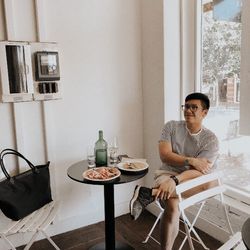Stranger & Stranger
Takeda Winery
Vin de Michinoku Tohoku Red blend 2017
This wine was given to me by a stranger, whom I now call friend, on our first meeting while I was traveling in Japan. Why? Just because I was curious. He spoke no English, I spoke no Japanese, but wine was our language and Google was the enabler.
The wine is an oddity - made of 6 grapes from the 6 prefectures of Tohoku, bottled fresh post-ferment, meant to be drunk across the country at 1900 on 11th March each year, to commemorate the losses of the 311 Tohoku Earthquake.
For me, this wine exemplifies all the good in wine. Wine has the uncanny ability to break down barriers, and to bring out the spirit of generosity, but most importantly, to make people happy. And this wine is happy! It's bright, fresh, umami, super glouglou, made for a good cause, shared among good people :) Happy happy! — 7 years ago
Marc Plouzeau
Rive Gauche Chinon Rosé Cabernet Franc
Yummy and juicy, tasted at Prospect, watching Stranger Things in a saree — 7 years ago
Peay Vineyards
Sonoma Coast Pinot Noir 2014
Rich, ripe black cherry, fleshy dense core. Earthy, black mushroom, sandlewood, and woodsy spice with soft texture and juicy fresh acidity. Pairs great with stranger things!🙃 — 8 years ago
Gramercy Cellars
Forgotten Hills Vineyard Syrah 2013
A bout between 2013 Washington Syrahs for a New Years celebration. K Vintners Motor City Kitty vs Gramercy Forgotten Hills. When comparing these two, I can't help but think of the show Stranger Things. These two wines are parallel universes, and it starts with the color. The MCK is a dark, deep purple, while he FH is medium purple. On the nose, the MCK gives dark red fruit and a dirty, spicy note as if you just went out to the garden and picked a jalapeño, some cilantro, celery and grabbed a handful of black raspberry and a plum and rubbed them all in your hand. The FH on the other hand is fresh and vibrant with red fruit, cured meats and savory herbs. On the palate, MCK has pruney raspberry, plum skin, with pepper and earth greenness. The FH has bright red fruits - strawberries, raspberries wrapped in plum skin with a dash of pepper and tar - with medium plus acid and great grip. Depending on you mood or palate, if you're in a mood for a dark, dirty Syrah go for the MCK, and a bright fresher Syrah for FH. Both great! — 8 years ago
Hesketh
Perfect Stranger Krems Grüner Veltliner
Very light color, but the taste was surprising complex. Fruit driven with a balance of acidity and a nice light oak flavor. I enjoyed the wine and would like to buy some more for consuming soon. — 8 years ago
Giacomo Ascheri
Do Ut Des Verduno Pelaverga
Total gem--a stranger to the varietal. Robust but not cloying. Some fun jagged black pepper upon the finish. $20. Purchased at WW. (Paired w/carbonara) — 9 years ago
François Crochet
Sancerre Rouge Pinot Noir 2016
Had the chance to taste this when a stranger poured me a glass at Le Coq Rico, Paris. Amazing. — 6 years ago
Tenuta di Arceno
Valadorna Toscana Red Blend 2009
Sitting on the soft, grassy hillside of a beautiful Tuscan Villa, looking out over the peaceful rolling hills, bathed in sunshine. As you take in this magestic pastoral scene, a stranger appears.... he's wearing a baseball cap and listening to an iPod.... Must be an American. But, strangely.... This adds to the experience. — 7 years ago
Marchesi Antinori
Solaia Cabernet Sauvignon Blend 2008
2️⃣0️⃣0️⃣8️⃣
🗞 $2.8 Trillion subprime 📉, Large Hadron Collider, 1st👨🏾president
🎵 Bleeding Love, Single Ladies
🎥 Dark Knight, Iron Man, Slumdog Millionaire, WALL-E
🗣 What doesn't kill you makes you stranger
🌍 6.7B
😍 @ £100 paid! Bargain 😁
🍷 Opaque ruby
👃 Melted rich mint cocoa, ripe black fruits, dark plum, blueberry & herbs w/ minerals, gravel, earth, violets & leather
👄 Full bodied silky rich creamy cocoa covered blackcurrant, blueberry & cherry
🎯 Long teeth staining black & blue fruit + mocha 💥 — 7 years ago
Columbia Crest
H3 Horse Heaven Hills Cabernet Sauvignon 2015
Pairs well with pretty women and Stranger Things. — 7 years ago
Fetzer Vineyards
Goosefoot Road Monterey County Riesling
YUM. Home chef, wine and stranger things binge with my boo. — 8 years ago
Belle Glos
Dairyman Russian River Valley Pinot Noir 2015
Awesome wine. Stranger. Suggested it. Glad we listened! — 8 years ago
Charles Smith
M.C.K. (Motor City Kitty) Syrah 2013
A bout between 2013 Washington Syrahs for a New Years celebration. K Vintners Motor City Kitty vs Gramercy Forgotten Hills. When comparing these two, I can't help but think of the show Stranger Things. These two wines are parallel universes, and it starts with the color. The MCK is a dark, deep purple, while he FH is medium purple. On the nose, the MCK gives dark red fruit and a dirty, spicy note as if you just went out to the garden and picked a jalapeño, some cilantro, celery and grabbed a handful of black raspberry and a plum and rubbed them all in your hand. The FH on the other hand is fresh and vibrant with red fruit, cured meats and savory herbs. On the palate, MCK has pruney raspberry, plum skin, with pepper and earth greenness. The FH has bright red fruits - strawberries, raspberries wrapped in plum skin with a dash of pepper and tar - with medium plus acid and great grip. Depending on you mood or palate, if you're in a mood for a dark, dirty Syrah go for the MCK, and a bright fresher Syrah for FH. Both great! — 8 years ago
Stranger & Stranger
The One Armed Man Limited Release Red Blend
Very good. — 7 years ago
Château Brane-Cantenac
Grand Cru Classé en 1855 Margaux Red Bordeaux Blend 2005
I have a six-pack of this 05. I thought after 10 years in bottle, it would be interesting to check in on its evolution. While tasty, I’ll wait another 8-10 to open another. Even after 2-3 hours in the decanter, it’s still a very young adolescent. On the nose, slightly sour blackberries & dark cherries, dark currants, baked black plum, haunting blue fruits, anise, whiff of spice, steeped tea, dry stones, dry crushed rocks with dry top soil, caramel, vanilla with fresh & dry red florals. The body is thick & full. Tannins are starting to round out. It’s velvety on the palate. The fruits are; bright, fresh & ripe and really show the greatness of the 05 vintage. Dark currants, blackberries, dark cherries, baked black plum, haunting blue fruits, baked strawberries, cherries, raspberries on the long set, dark spice, clay & loamy dry top soil with crushed rocks, dry stones, cigar with ash, graphite, dry stems, slight herbaceous character, mint, used leather, clove, caramel, vanilla, fresh & dry red florals with violets. The round acidity is about perfect. The structure and length are still strong. The balance is in harmony. As for the long finish, it’s lush, ruby, rich and well polished. Photos of; Chateau Brane Cantenac, large wood vats, Henri Lurton and Estate vines. Producer notes and history...Chateau Brane Cantenac began in the early 17th century. At the time, the estate was known as Domaine Guilhem Hosten. Even that far back, wine was produced from the property. In fact, the wine was so highly regarded it was one of the more expensive wines in Bordeaux. It sold for almost as much money as Brane Mouton. This is interesting because of who went on to buy the vineyard in the 1800’s. The Baron of Brane, also known as “Napoleon of the Vineyards”, purchased the Chateau in 1833. At the time of the sale, the estate was called Chateau Gorce-Guy. To get the funds needed to purchase the Margaux vineyard, the Baron sold what is now called Mouton Rothschild, which was at the time of the sale, known as Chateau Brane-Mouton. Not such a good move with hundreds of years in hindsight! In 1838, the Baron renamed property taking his name and the name of the sector where the vineyards were located and called it Chateau Brane Cantenac. The Chateau later passed to the Roy family, who were well-known in the Margaux appellation in those days, as they owned Chateau d’issan. Moving ahead to 1920, the Societe des Grands Crus de France, a group of merchants and growers that owned several chateaux located in the Medoc including; Chateau Margaux, Chateau Giscours, and Chateau Lagrange in St. Julien, purchased Chateau Brane Cantenac. Five years later, M. Recapet and his son-in-law, François Lurton, took over Brane Cantenac along with Chateau Margaux. Lucien Lurton (the son of François Lurton) inherited Brane Cantenac in 1956. Today, the estate is still in the hands of the Lurton family. Brane Cantenac is owned and run by Henri Lurton. After being given the responsibility of managing Brane Cantenac, it was under the direction of Henri Lurton that large portions of the vineyard were replanted. Vine densities were increased, the drainage systems were improved and the plantings were also, slowly changed. The vineyard of Brane Cantenac is planted to 55% Cabernet Sauvignon, 40% Merlot, 4.5% Cabernet Franc and .5% Carmenere. Carmenere was used for the first time in the 2011 vintage. The only other Chateau I know that still uses Carmenere is Clerc Milon. The 75 hectare Left Bank vineyard of Brane Cantenac is essentially unchanged since it earned Second Growth status in the 1855 Classification. At least that is the case with the 45 hectares used to produce the Grand Vin of Brane Cantenac. Those 45 hectares are planted surrounding the Chateau. Those vines are located just in front of the Cantenac plateau and are the best terroir that Brane Cantenac owns. They have other parcels, which are further inland and much of those grapes are placed into their second wine, Le Baron de Brane. Those additional hectares can be divided into 3 main sections. Behind the Chateau, they have 15 hectares of vines on gravel and sand, 10 hectares across the road with sand, gravel and iron and a 13 hectare parcel with gravel called Notton, which is used for their second wine. The vineyard is planted to a vine density that ranges from 6,666 vines per hectare on the plateau and up to 8,000 vines per hectare for the vines located behind chateau, in their sandier soils. The higher levels of vine density are always found in the newer plantings. The terroir of Brane Cantenac consists of deep gravel, sand and clay soil. Experiments in the vineyards are currently looking at becoming more organic in their vineyard management. Today, more than 25% of Brane Cantenac is farmed using organic farming techniques. It is expected that over time, the amount of hectares farmed with organic methods will be increased. Brane Cantenac has gone through 2 relatively recent modernization’s in 1999, when they added began adding the first of their smaller vats to allow for parcel by parcel vinification and then again in 2015 when they completed a much more complete renovation of their cellars and vat rooms. While Brane Cantenac is a traditional producer, they are no stranger to technology as they were one of the first estates to embrace optical grape sorting machines. In very wet vintages, they can also use reverse osmosis. To produce the wine of Chateau Brane Cantenac, the wine is vinified in a combination of temperature controlled, traditional, 22 oak vats, 18 concrete tanks and 20 stainless steel vats that vary in size from 40 hectoliters all the way up to 200 hectoliters, which allows for parcel by parcel vinification. 40% of the fermentation takes place in the oak vats. The oldest vines are vinified in vats that are selected to allow for separate parcel by parcel vinification. The younger vines are vinified more often together in the same vats. However, the Carmenere is entirely micro-vinified, meaning that those grapes were completely vinified in barrel, using micro-vinification techniques. This can also happen because the amount of grapes produced is so small. Some vats can be co-inoculated, meaning they go through alcoholic fermentation and malolactic fermentation simultaneously. At Chateau Brane Cantenac, malolactic fermentation takes place in a combination of French oak tanks and barrels. The wine of Brane Cantenac is aged in an average of 60% new, French oak barrels for 18 months before bottling. The initial 2 months of aging is done with the wine on its lees, which adds more depth to the wine. There second wine is Le Baron de Brane. Le Baron de Brane is not new. In fact, previously, the second wine went under the name of Chateau Notton, which took its name from one of the main parcels where the grapes were planted. During the late 1950’s and into the 1960’s, having a second wine was important as the estate declassified 3 vintages, due to extremely poor, weather conditions in 1956, 1960 and 1963. Production of Chateau Brane Cantenac is about 11,000 cases per year. — 7 years ago

Austerity
Paso Robles Cabernet Sauvignon 2013
Like being bitten by a stranger / Dark, sharp, unexpected / — 9 years ago













Eric Adams
Cinco de Mayo — 6 years ago